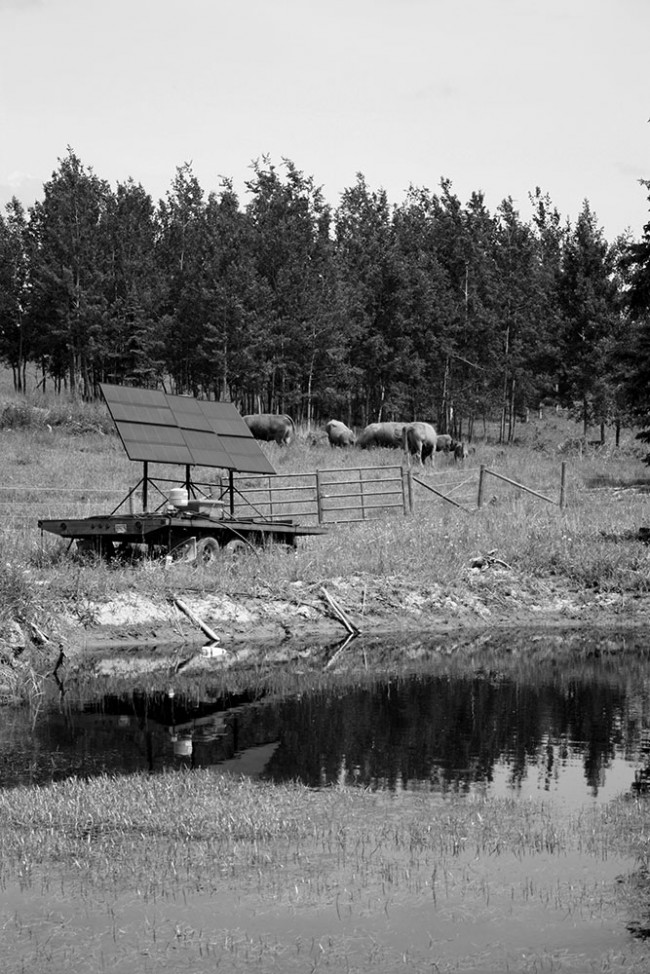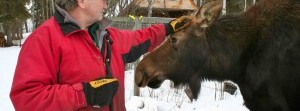
Photo Credit: Norma Kerby
Cows vs. Frogs: Fort Fraser Ranch promotes amphibian biodiversity
“Here’s something worthwhile. A rancher in the Fort Fraser area wants to monitor for us. He says that they have lots of amphibians and snakes on their ranch—at least five different species.”
We were in the process of selecting long-term monitoring sites for the Northwest BC Reptile and Amphibian Monitoring Program (NWBC RAMP). Fort Fraser does not have the reputation of being a frog hotspot, but—if the contact was correct—there had to be something special about this ranch to have such strong amphibian populations.
That summer, as field assistant Ken Adair and I installed monitoring sites at Smith Creek Farms, 20 kilometres south of Fort Fraser, we soon discovered one of the areas of richest biodiversity of anywhere we’d been in Northwest BC. This striking biological complexity appears to be the product of the area’s diverse geography combined with special management practices by the ranch’s owners.
Frog-friendly fencing
Wayne and Cathy Ray started their family-run cattle and hay operation in 1990, building their property holdings to 900 hectares of productive land located on the ancient glacial lake sediments of the Nechako drainage. These poorly drained clay soils are covered with a wealth of water bodies. On Smith Creek Farms alone there are 32 small ponds, four large wetland complexes, seven lakes and three year-round streams. This amazing diversity of aquatic habitats is one of the major factors that attract so many amphibian species to the property.
Each pond on the ranch has its own unique qualities. “Now this one,” Wayne says, as he stops his four-wheel-drive truck next to a small pothole in a grove of aspen, “has lots of reeds and fallen trees. Every year there are breeding wood frogs here even when it is mostly covered with ice. I’ve never seen red-legged Columbia spotted frogs at this pond, though. They seem to like the larger ponds with more open water.”
From the fencing around this pothole, it’s obvious that cattle are not allowed close to the shoreline. In 2004, worried about damage to the sensitive riparian vegetation around their lakes and ponds, Wayne and Cathy purchased a mobile pump powered by solar panels. This pump is used to fill large portable drinking troughs. As the cattle move through 10 different grazing pastures over the summer, the pump moves with them, limiting the impact of trampling in the ponds and allowing the most sensitive wetlands to be fenced.
“If we don’t need the water, or can use the solar pump instead, we fence off our smaller pools,” he explains. “It stops the cows from wrecking the shoreline and fouling the water. If we want the water as a back-up, then by putting a trough of water closer to the grazing area most of the cattle will drink from the trough and not go to the pond.”
Some of the ranch’s ponds have also been deepened to ensure that there is sufficient water during the driest part of the summer. In addition, dugouts have been constructed along ditch lines and in damp hollows. These all appear to have helped the amphibian populations.
Contributing to science
“Look at all of those tadpoles and larvae!” Ken leans over the water edge, trying to get a count along a section of the pond. An amazing number of toad tadpoles and long-toed salamander larvae are swimming across the shallow end of the dugout. To maximize amphibian habitat, Wayne constructs his dugouts in steps, with a shallow end for egg-laying activities and habitat for young tadpoles and the deeper end to ensure that there is water for both his cattle and frogs in the hottest part of summer.
Wayne also leaves pieces of wood around the periphery of ponds and dugouts to provide shelter for long-toed salamanders. “I’ve found them frozen early in the spring under the wood,” he says, lifting up a log to see if any salamanders are there. “A couple weeks later, nothing is under the wood and the salamanders are breeding in the pond.”
As we drive around the maze of fields and aspen groves, Wayne describes how the ranch has deliberately retained patches of forest and shrubby wetlands. “We don’t cut all of the trees. Years ago, when I talked to the old-timers, they said that before the government started controlling forest fires the land around here had lots of natural meadows. We’ve tried to clear our land to what it would have been when those meadows were still here. The forested areas are on the poorer soils and the grazing areas and hayfields are on the better, flatter ground. The forests keep the ground moist and prevent erosion on the slopes.” From the number of tracks and droppings, the forests also keep a high diversity of wildlife species on the property, as well as a rich array of native plants and insects.
In their 2005 Environmental Farm Plan, Wayne and Cathy were able to document over 800 plant and animal species that use the ranch lands for all or a portion of the year. These species range from nesting sandhill cranes and sharp-shinned hawks to a Mexican caracara eagle that made a surprise visit to the ranch in 2008. This striking biodiversity is important for species records in BC. Since 2011, Wayne and Cathy have collected insects and spiders for the Royal BC Museum. They have also accommodated research projects from the UNBC and recorded amphibian and garter snake sightings for the provincial species records inventory through the Northwest BC Reptile and Amphibian Monitoring Program.
Biodiversity meets productivity
Does accommodating natural biodiversity allow a ranch in northern BC to be economically viable? According to Wayne and Cathy, the productivity of their land has been maintained, and erosion and land degradation have been prevented by their ecologically sensitive management techniques. At their average cattle density of 150 breeding cows, and by rotating grazing fields throughout the summer, they are able to keep their farm productive and their land base stable. The high biodiversity levels have also led to another form of income for the ranch—wildlife and nature photos through a nature photography business.
But ranching is not easy. Severely hit by market impacts from BSE (mad cow disease) in 2003, followed closely by woodlot revenue losses from the mountain pine beetle infestation, ranching has struggled economically along the Highway 16 corridor. Even with last year’s higher beef prices, it is often a luxury to be able to afford to protect wildlife habitat on a ranch. In the balance between maintaining pasture and water for higher densities of cattle, and habitat for amphibian species, the Rays have made a deliberate decision to preserve the frogs, snakes and salamanders that live on their farm.
Ask Wayne what worries him most about the prolific amphibians on his property and he doesn’t hesitate: “The toads,” he says. “At night there can be 50 of them sitting on the road into the ranch. It is very slow driving trying to miss them.”
Despite being a blue-listed threatened species, the western toads at Smith Creek Farms are thriving in a location where they and their habitat are considered important additions to the value of a cattle ranch.






Great example of wildlife and ranching sustainability!
👤 Joanne 🕔 Sep 20, 2015
It is heart warming to read about farmers that integrate concern for the environment with their farm livelihood
👤 John Franken 🕔 Nov 01, 2015